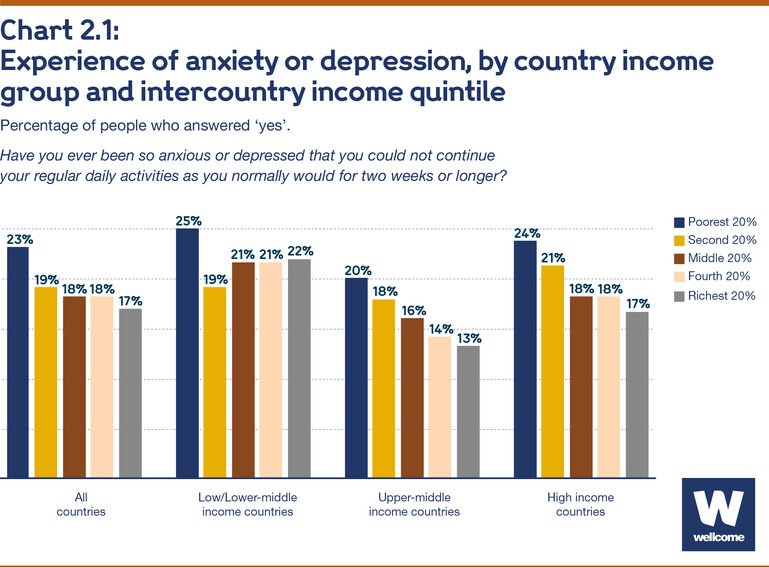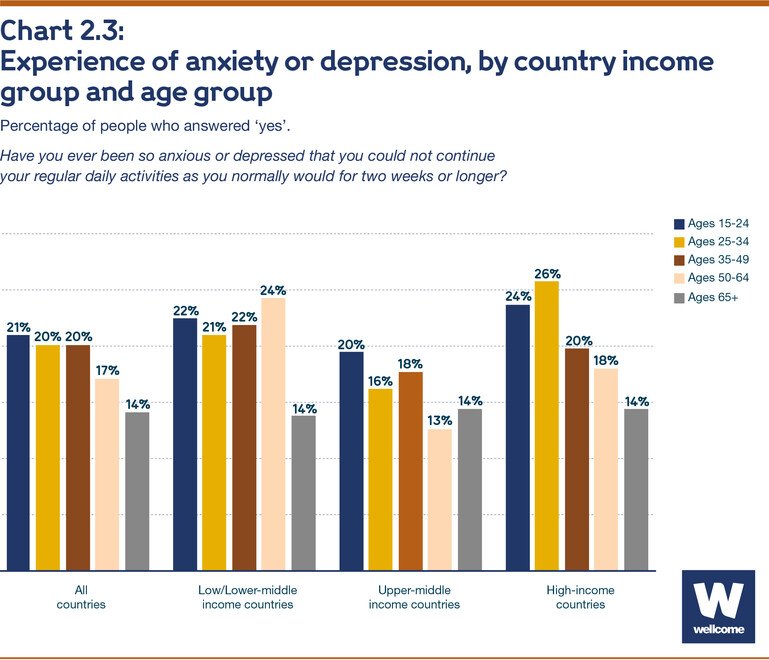Chapter 2: Experience of anxiety or depression
This is chapter 2 of the Wellcome Global Monitor 2020: Mental Health
There are varying estimates of the numbers of people in different populations across the world who experience mental health problems. This chapter considers responses to the following questions:
- Have you ever been so anxious or depressed that you could not continue your regular daily activities as you normally would for two weeks or longer?
- Just your best guess, about how old were you when you first felt [anxiety or depression]?
- Have you felt this way more than once?
Worldwide, about one in five people (19%) said they have experienced anxiety or depression (defined as being ‘so anxious or depressed that you could not continue your regular daily activities as you normally would for two weeks or longer’).
Rates of anxiety or depression varied by income
Chart 2.1 identifies the modest rate differences by income level between and within countries, with people in lower-income brackets reporting somewhat higher rates of anxiety or depression. Globally, 23% of people in the bottom fifth of their country’s income distribution said they have experienced anxiety or depression, compared with 17% of those in the top fifth. This pattern was more consistent in upper-middle- and high-income countries and areas than in lower-middle-income countries.
Chart 2.1: Experience of anxiety or depression, by country income group and intercountry income quintile
Percentage of people who answered ‘yes’.
Have you ever been so anxious or depressed that you could not continue your regular daily activities as you normally would for two weeks or longer?

The prevalence of anxiety or depression was broadly consistent across regions
Chart 2.2 reveals that the proportion of people who said they have experienced anxiety or depression was relatively consistent across most global regions, ranging from 18% to 27% in all regions except Latin America and East Asia. Results in these outlier regions probably reflect actual differences in anxiety or depression but may also be subject to sociocultural effects that make people more or less likely to discuss such conditions.
- In Latin America, one in three people (33%) said they have been so anxious or depressed they could not continue their regular daily activities for two weeks or longer. Gallup’s global research has consistently shown that Latin Americans are more likely than people in other regions to say they have experienced both positive and negative emotions for much of the previous day (1).
- In East Asia, about one in 11 people (9%) said they have been so anxious or depressed they could not continue their regular daily activities for two weeks or longer – easily the lowest percentage among the 11 global regions surveyed. Recent studies have shown that high levels of stigma concerning depression remain in China, which may reduce respondents’ willingness to admit to having experienced it (2,3).
Chart 2.2: Anxiety and depression are experienced by people worldwide
Percentage of people who answered ‘yes’.
Have you ever been so anxious or depressed that you could not continue your regular daily activities as you normally would for two weeks or longer?
Hover over the circles to view the country level results in the region.
Interact with the data in more detail via the chart below
Demographic differences in experiences of anxiety or depression varied worldwide
Age
At the global level, the likelihood of having experienced anxiety or depression decreased with age. Chart 2.3 demonstrates that people in older age groups were somewhat less likely to say they have experienced anxiety or depression than younger people – 17% of people aged 50-64 and 14% of those over the age of 65, compared with 20% of people under 50. This finding is notable given that older people have had more time to have such experiences. Young adults in high-income countries were particularly likely to say they have experienced anxiety and depression, including 24% of those aged 15-24 and 26% of those aged 25-34, compared with 18% of those aged 35 and older.
Chart 2.3: Experience of anxiety or depression, by country income group and age group
Percentage of people who answered ‘yes’.
Have you ever been so anxious or depressed that you could not continue your regular daily activities as you normally would for two weeks or longer?

Most people who have experienced anxiety or depression have had more than one episode.
Almost three quarters (73%) of people who have experienced anxiety or depression said they have felt this way more than once in their lives. Chart 2.4 shows the different ages at which people first encountered these mental health experiences. The majority had their first experience before turning 30 (though figures for older age groups are limited because many people have not yet reached those ages). These findings were consistent across all country income groups.
Chart 2.4: Age at which people first experienced anxiety or depression, by country income group and age group
Percentage among people who said they have experienced anxiety or depression.
Just your best guess, about how old were you when you first felt [anxiety or depression]?

Gender
Despite prior research indicating that women in many countries are more likely than men to suffer from anxiety or depression (4), this survey finds only a slight difference at the global level: 20% of women said they have experienced anxiety or depression, compared with 18% of men. However, these global figures are heavily influenced by the results from the world’s two largest countries, China and India, where similar levels of women and men were likely to say they have had these issues (9% of women compared with 8% of men in China, and 23% of women compared with 22% of men in India).
At the country level, women were significantly more likely than men to say they have experienced anxiety or depression in 39 of the 113 countries and areas surveyed, while men were more likely to respond this way in only six such areas. Table 2.1 lists countries with at least a 10-percentage-point gender gap.
Table 2.1: Country-level gender gaps regarding experiencing anxiety or depression*
Percentage of people who answered ‘yes’.
Have you ever been so anxious or depressed that you could not continue your regular daily activities as you normally would for two weeks or longer?
| Women | Men | Difference | |
|---|---|---|---|
| Portugal | 35% | 17% | 18 pts |
| Chile | 46% | 28% | 18 pts |
| Poland | 29% | 12% | 17 pts |
| Greece | 41% | 27% | 14 pts |
| El Salvador | 44% | 31% | 13 pts |
| Costa Rica | 39% | 27% | 12 pts |
| United States | 27% | 15% | 12 pts |
| Colombia | 36% | 24% | 12 pts |
| Argentina | 41% | 30% | 11 pts |
| Uruguay | 28% | 17% | 11 pts |
| Ecuador | 48% | 37% | 11 pts |
| Men | Women | Difference | |
|---|---|---|---|
| Tanzania | 34% | 20% | 14 pts |
| Saudi Arabia | 35% | 23% | 12 pts |
| Bangladesh | 26% | 14% | 12 pts |
| Malaysia | 25% | 14% | 11 pts |
| Congo Brazzaville | 31% | 21% | 10 pts |
* Results among countries with a gender gap of at least 10 percentage points.
Read all chapters
Endnotes
- Clifton, J. (2015, August 7). Latin Americans lead world in emotions. Gallup.com. https://news.gallup.com/poll/184631/latin-americans-lead-world-emotions.aspx
- Yang, F., Yang, B. X., Stone, T. E., Wang, X. Q., Zhou, Y., Zhang, J., & Jiao, S. F. (2020). Stigma towards depression in a community-based sample in China. Comprehensive Psychiatry, 97, 152152. https://www.sciencedirect.com/science/article/pii/S0010440X19300756
- Xu, X., Li, X.-M., Zhang, J., & Wang, W. (2018). Mental health-related stigma in China. Issues in Mental Health Nursing, 39(2), 126-134. https://www.tandfonline.com/doi/abs/10.1080/01612840.2017.1368749?journalCode=imhn20
- Kuehner, C. (2017). Why is depression more common among women than among men? The Lancet Psychiatry, 4(2), 146-158. https://www.thelancet.com/pdfs/journals/lanpsy/PIIS2215-0366(16)30263-2.pdf
